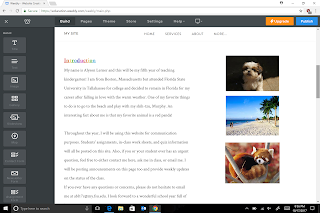Blog Journal 8
Adaptive technologies are technologies that help disabled students effectively use computing tools. By using adaptive technology, these students are able to learn independently and participate more in class. Also, dyslexic students are able to use a spell checker or speech recognition software to assist them while writing. When I was volunteering at a kindergarten summer camp, I saw three students with disabilities using adaptive technologies. Each of these students had their own iPad and a pair of headphones to aid them in classroom activities. The students were also guided by a teacher helper at most times. One challenge I perceive using adaptive technologies in the classroom is the destruction or damage to items. Especially with younger kids, they often throw the iPads. I had experience with this during the summer camp as one of the girls would throw the iPad around rather than answering questions. Therefore, a student that might damage the iPad or other technological item may require constant supervision.
Bloom's Taxonomy is definitely something I could use during Powerpoints to support student learning. At the remember level, I could repeat facts and information that I am trying to stress the importance of. Also, if I keep repeating the information, students are more likely to recall it on the test or quiz. At the understand level, I could explain the topic in a clear and detailed manner. I could also rephrase it in different ways to ensure understanding. At the apply level, I could relate the topic to a real life example or demonstrate its importance in the real world. At the analyze level, I could allow the students to ask questions. I could also compare or contrast the topic to that of another to maybe increase understanding. For example, I could compare WWI and WWII in a history class. At the evaluate level, I could break down the topic and maybe have a debate about it. For instance, in English class we used to have to take a side on articles and then debate over it as a class. At the create level, I could investigate the topic further and maybe draw my own conclusions or have the students form their own opinions.
https://www.popsci.com/technology
PopularScience.com is a website that addresses the current technological trends and constantly updates to ensure validity. If I checked this website on a weekly or even daily basis, I could stay on top of technological trends and find out about new technology even before it hits the market.
Bloom's Taxonomy is definitely something I could use during Powerpoints to support student learning. At the remember level, I could repeat facts and information that I am trying to stress the importance of. Also, if I keep repeating the information, students are more likely to recall it on the test or quiz. At the understand level, I could explain the topic in a clear and detailed manner. I could also rephrase it in different ways to ensure understanding. At the apply level, I could relate the topic to a real life example or demonstrate its importance in the real world. At the analyze level, I could allow the students to ask questions. I could also compare or contrast the topic to that of another to maybe increase understanding. For example, I could compare WWI and WWII in a history class. At the evaluate level, I could break down the topic and maybe have a debate about it. For instance, in English class we used to have to take a side on articles and then debate over it as a class. At the create level, I could investigate the topic further and maybe draw my own conclusions or have the students form their own opinions.
https://www.popsci.com/technology
PopularScience.com is a website that addresses the current technological trends and constantly updates to ensure validity. If I checked this website on a weekly or even daily basis, I could stay on top of technological trends and find out about new technology even before it hits the market.


Comments
Post a Comment